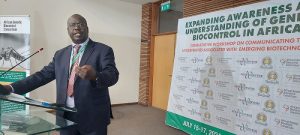African Union (AU)’s quest for member countries to embrace and apply modern scientific tools including biotechnology to redeem Africa’s agriculture from the vagaries of pests, diseases and undesirable climatic conditions, will require the commitment of all stakeholders especially scientists, science communicators and science journalists.

This group of stakeholders include those who generate, translate, repackage and disseminate information to targeted stakeholders and the general public. They play a key role in the processes that may lead to successful public input and eventual key support in the development, decision-making and adoption of biotechnology and genetic biocontrol technologies for animal, public health, and conservation in Africa.
“Therefore, it is critical that this group of people gain an understanding of how biotechnology intersects with globalisation, trade, poverty, food security, disease control and environmental sustainability,” says Dr. Willy Tonio, head of the African Genetic Biocontrol Consortium (GenBio Consortium) Secretariat. He strongly felt that such communicators needed to sharpen their skills to craft thoughtful and effective arguments, with supporting evidence at the intersection of science and social science on issues of public policy and applicable laws and regulations.
The Arusha Science Communication Workshop
To this end, the GenBio Consortium in partnership with the East African Science and Technology Commission (EASTECO), brought together a group of 20 scientists, science communicators, editors and journalists from Ghana, Kenya, Tanzania, Uganda, Rwanda, South Africa, Zambia and Zimbabwe, to develop their capacity on science communication at a three-day workshop sometime in July 2024, in Arusha, Tanzania.
Their focus was on how to utilise appropriate communication tools and practices to advance informed decision-making for development of genetic biocontrol technologies for animal, public health, and conservation, particularly in the Eastern and Southern African region. Again, it was to increase the number of people with sufficient knowledge and understanding to be able to effectively communicate genetic biocontrol within that region.
The workshop was also an occasion to strengthen alignment among stakeholders to build future collaborative efforts in risk communication that support decision-making processes for genetic biocontrol agents or products in Eastern and Southern African countries.
The Communique
Following the three days of deliberations, the participants issued a communique, calling for enhanced relationships between scientists and communicators/journalists in order to improve dissemination of scientific findings in a simplified manner.
According to the communique, one way of enhancing scientists and media relationship, was for scientific institutions to conduct exhibitions and “seeing is believing” tours to enable communicators and journalists better appreciate ongoing field trials in genetic biocontrol research, for example.
It proposed the establishment of scientists and media partnerships through which scientists could share their research findings, while journalists would have access to reliable sources and also verify scientific facts before publishing their news stories. Such partnerships could facilitate the creation of platforms to prioritise discussions on science matters focusing on emerging technologies.
The communique further called for the identification of biotechnology champions from both scientists and journalists to spearhead and maintain relevant and important topics within the public domain.
It encouraged the development and submission of joint proposals during calls for applications for funding of projects. This is to ensure that communication needs were fully incorporated at the proposal stages.
On the subject of increasing general knowledge and media coverage of science matters as well as build a critical mass of science communicators, while fostering a society that values science innovation and evidence-based decision making; the communique advocated the development of a training manual/curriculum that also provides guidelines on biotechnology communication.
The communique ended on a note of anticipation for the recommendations to serve as an input to consultations among all stakeholders tasked with furthering implementation, monitoring and evaluation of emerging technologies in their countries.
Excerpts of the opening session of the Workshop
Earlier at the opening session, Prof. Dorington Ogoyi of the Technical University of Kenya presented an overview on the International and regional frameworks governing biotechnology and biosafety. He recalled that the Cartegena Protocol on Biosafety is a supplementary agreement to the Convention on Biological Diversity (CBD) and is a major global instrument on the movement of Living Modified Organisms (LMO) for the safety of the environment, human and animal health.
The Protocol was adopted in January 2000 by the Conference of Parties (COP) to the CBD and came into force in September 2003. It has established rules and procedures based on five core areas. These are: procedures for moving LMOs across borders, risk assessment procedures, the biosafety clearing house, capacity building and public awareness.
The Executive Director of EASTECO, Sylvance Okoth, reminded participants that there is a lot of work to be done and “it begins with proper science communication.” He further reminded them of how inaccurate information adversely impact communication and urged them, “to ensure that great care is taken on the kind of messages they pass onto specific target groups.”
The Executive Director of the Kenya Editors Guild, Rosalia Omungo, was of the view that the fact that the technology was still developing, is an opportunity for journalists to focus on science and sustainability.
She stated: “The beauty of the technology is how well we communicate the message of how the technology is scaling up food security.”
By Ama Kudom-Agyemang
